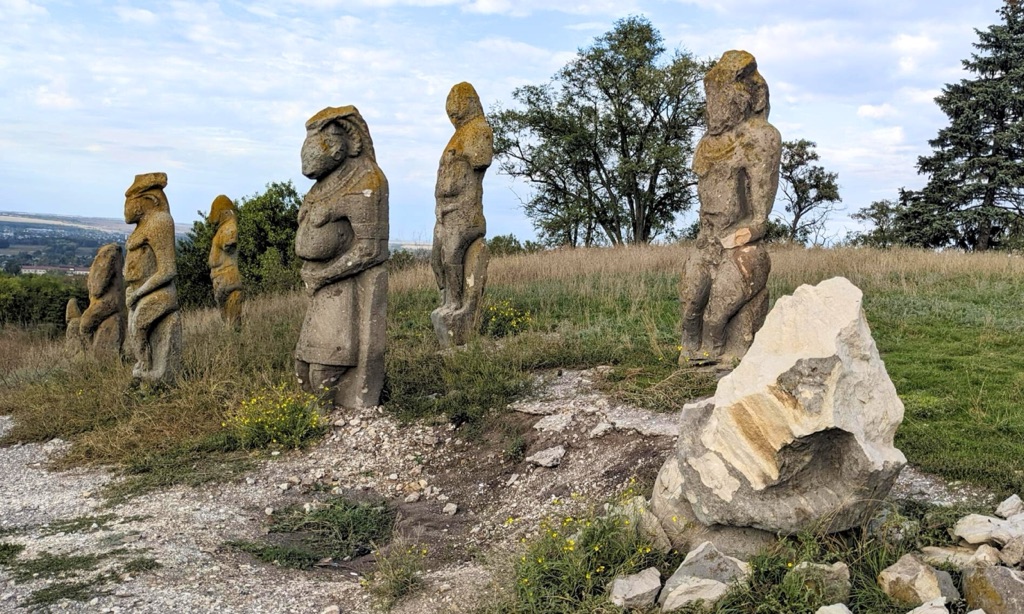The Polovtsian Babas, also known as stone babas or kurgan stelae, are a mysterious collection of anthropomorphic stone statues. They date back to the medieval period, standing as intriguing remnants of the Cumans’ or Polovtsy’s historical presence in Eurasia. The statues feature human-like figures, often depicted with facial features and ornaments, symbolizing historical and cultural narratives. Erected primarily in the steppes of Ukraine and southern Russia, these enigmatic figures captivate historians and tourists alike. They reveal insights into the artistry, beliefs, and societal structure of the nomadic tribes that once flourished in these lands.
Polovtsian people
The Polovtsian people, also known as the Cumans or Kipchaks, were a nomadic Turkic tribe that played a significant role in the history of Eastern Europe and the Eurasian Steppe from the 11th to the 13th centuries AD. Originating from the steppes of Central Asia, they migrated westward, reaching the area north of the Black Sea and the Volga River. This migration brought them into the territories that are now parts of modern-day Ukraine, Russia, and Kazakhstan, where they established themselves as a formidable force.
Throughout their history, the Polovtsians were involved in numerous conflicts and alliances, notably with the Byzantine Empire, the Kingdom of Hungary, and various Russian principalities. One of their most significant confrontations was with the Rus’ in 1185, immortalized in the epic poem “The Tale of Igor’s Campaign.” This literary work not only highlights the military aspects of the Polovtsian-Rus’ relations but also provides insights into the cultural and social interactions between these peoples.
The Polovtsians practiced a form of Tengrism, a Central Asian religion that worshipped the sky god Tengri, alongside other animistic and shamanistic beliefs. Their religious practices were deeply intertwined with their nomadic lifestyle, emphasizing respect for nature and ancestor worship. Over time, especially through interactions with neighboring cultures, some Polovtsians converted to Islam and Christianity, reflecting the diverse religious landscape of the medieval Eurasian Steppe.
Socially and economically, the Polovtsians were organized into a tribal confederation led by a khagan or khan. Their society was pastoral, with horse breeding, hunting, and trading being integral to their daily life. The mobility provided by their horses was crucial for their way of life, enabling them to move their herds, conduct raids, and engage in trade across vast distances. The Polovtsians were also known for their skills in metalworking, particularly in the crafting of jewelry and weapons.
The daily life of the Polovtsian people was characterized by their nomadic lifestyle, with families living in portable tents known as yurts. Their diet primarily consisted of meat and dairy products from their livestock, supplemented by trade goods obtained from neighboring peoples. The Polovtsians were also renowned for their equestrian skills, which were essential for warfare, hunting, and managing their herds.
The leadership of the Polovtsians was not centralized, consisting instead of a confederation of tribal leaders who would elect a supreme khan in times of need. Among the most notable leaders was Khan Kobyak, who led the Polovtsians in several successful campaigns against their neighbors. However, the lack of a centralized authority often led to internal divisions, which, along with external pressures, contributed to their decline.
By the early 13th century, the Polovtsian way of life and independence were threatened by the Mongol invasions led by Genghis Khan. The Mongols defeated the Polovtsians in a series of battles, culminating in the Battle of Kalka River in 1223. Following their defeat, many Polovtsians were absorbed into the Mongol Empire, while others fled westward, seeking refuge among the kingdoms and principalities of Eastern Europe.
The legacy of the Polovtsian people is a testament to the rich and complex tapestry of Eurasian history. Their interactions with neighboring civilizations, contributions to the cultural and military landscape of the medieval period, and their adaptation and resilience in the face of adversity offer valuable insights into the dynamics of nomadic societies and their role in shaping the course of history.

